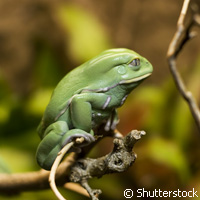How frog skin could hold the secret to cancer treatment
Proteins found in frog skins could soon be an instrumental part of treatment for over 70 serious conditions including cancer and diabetes, according to new research from scientists at Queen's University Belfast in the United Kingdom. The team discovered that two types of protein, or 'peptide', could be used under controlled conditions to regulate angiogenesis - the process of blood vessel growth in the body. So far, two types of frog have been found to possess these powerful proteins; the waxy monkey frog, a species which comes from the Phyllomedusinae subfamily of South- and Central-American leaf frogs found in the dry 'Chaco Plain' region of Argentina, Brazil, Bolivia and Paraguay, and the giant fire-bellied toad, from the Bombina toad family. In both frogs, the proteins were found nestled in secretions on their skins. After carefully extracting the secretions, the scientists released the unharmed frogs back into the wild. 'The proteins that we have discovered have the ability to either stimulate or inhibit the growth of blood vessels,' explains Professor Chris Shaw, who led the research. 'By 'switching off' angiogenesis and inhibiting blood vessel growth, a protein from the waxy monkey frog has the potential to kill cancer tumours. Most cancer tumours can only grow to a certain size before they need blood vessels to grow into the tumour to supply it with vital oxygen and nutrients. Stopping the blood vessels from growing will make the tumour less likely to spread and may eventually kill it. This has the potential to transform cancer from a terminal illness into a chronic condition.' The team also worked out that conversely, a protein extracted from the giant fire-bellied toad can work in the opposite direction and actually encourage angiogenesis and stimulate blood vessel growth. This has implications for a plethora of diseases that need blood vessels to repair quickly, such as wound healing, organ transplants, diabetic ulcers, and damage caused by strokes or heart conditions. Professor Shaw expresses his conviction that the greatest medical problems can be solved by looking to the natural world: 'The aim of our work is to unlock the potential of the natural world - in this case the secretions found on frog and toad skins - to alleviate human suffering. We are absolutely convinced that the natural world holds the solutions to many of our problems, we just need to pose the right questions to find them. It would be a great shame to have something in nature that is potentially the wonder drug to treat cancer and not aim to do everything in our power to make it work.' This shift towards exploring the potential of nature to help us find much-needed cures comes in light of the failure to combat processes like angiogenesis using other methods of drug development. Despite a worldwide investment of between USD 4 billion and USD 5 billion by scientists and drugs companies into angiogenesis research, these efforts have yet to yield the development of a drug that can effectively target, control and regulate the growth of blood vessels.For more information, please visit:Queen's University Belfast:http://www.qub.ac.uk/
Countries
United Kingdom



